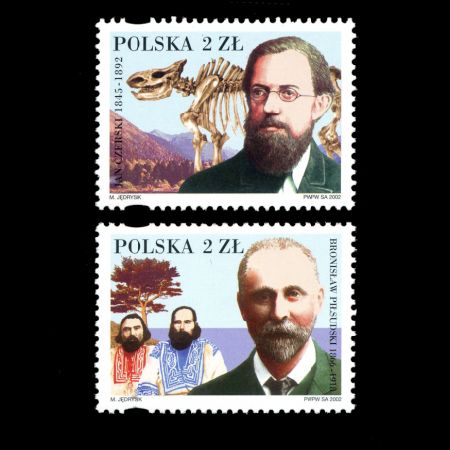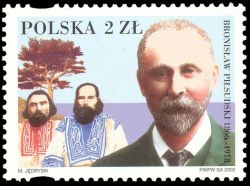Poland 2002 "Poles in the World"
| <prev | back to index | next> |
| Issue Date | 22.02.2002 |
| ID | Michel: 3953-3954; Scott: 3621-3622; Stanley Gibbons: 3974-3975; Yvert et Tellier: 3718-319; Category: pP |
| Design | Maciej Jedrysik |
| Stamps in set | 2 |
| Value |
2 zl - Jan Czerski with Coelodonta skeleton on the background 2 zl - Bronislaw Pilsudski |
| Emission/Type | commemorative |
| Places of issue | Warsaw |
| Size (width x height) | 43 mm x 31.25 mm |
| Layout | 20 stamps in sheet |
| Products | FDC x 2 |
| Paper | security, fluorescent |
| Perforation | 11.75 x 11.5 |
| Print Technique | Offset lithography |
| Printed by | State Printing Works of Securities Warsaw (PWPW) |
| Quantity | 500.000 sets |
| Issuing Authority | Polish Post |

On February 22nd, 2002, the Post Authority of Poland issued the set of two stamps "Poles in the World". These stamps presented two personages who lived and worked outside their motherland and have performed extraordinary works, leaving behind lasting signs and thus making famous the name of Poland.
The text below is a quote of the text published by Pocta Polska in 2002. This article doesn't exist on the Internet anymore.
The paragraph about Coelodonta was added by the author of this website.
Two big Polish explorers - Jan Czerski (1845 - 1892) and Bronislaw Pilsudski (1866-1918) were carrying on their works being sent on exile.
Jan Czerski has been serving a sentence in Omsk, Siberia for participation in the January Uprising.
 |
| Jan Czerski on stamp of Poland 2002, MiNr.: 3953, Scott: 3621. |
In the years 1871-1883 on instructions of the Russian Geographic Association he made many expeditions into the countryside. The most important of these expeditions aimed the study of the geological structure of the whole cost of the lake Baikal. The result of this work was a geological map of the costs of the lake Baikal for which work he had been awarded in Bologna.
In the years 1877-1881 during four scientific expeditions Czerski has explored the valley of the river Selenga and he wrote a study concerning Baikal, explaining the origin of the lake and presenting the geological structure of East Siberia.
He was decorated with the gold medal of the Russian Science Academy. During his expeditions he collected and cataloged over 2,500 of ancient bones, publishing in 1888 a large work on Quaternary Period mammals followed by an even larger work on the Siberian mammals relics in 1891.
 |
| Woolly Rhinoceros, Coelodonta antiquitatis, on stamps of Belgium 2018, MiNr.: 4851, Scott: 2871. |
Coelodonta, is an extinct genus of Eurasian rhinocerotoids from 3.7 million years to 14,000 years ago, in the Pliocene and the Pleistocene epochs. The earliest known species, Coelodonta thibetana, lived in Tibet during the Pliocene, with the genus spreading to the rest of Eurasia during the Pleistocene.
The best known from the type species, the woolly rhinoceros (Coelodonta antiquitatis), which ranged throughout northern Eurasia during the Pleistocene.
The woolly rhinoceros, Coelodonta antiquitatis, was a member of the Pleistocene megafauna. The animal was massive, with two large horns toward the front of the skull, and was covered with a thick coat of hair, that allowed it to survive in the extremely cold, harsh mammoth steppe. It had a massive hump reaching from its shoulder and fed mainly on herbaceous plants that grew in the steppe. Mummified carcasses preserved in permafrost and many bone remains of woolly rhinoceroses have been found. Images of woolly rhinoceroses are found among cave paintings in Europe and Asia. The species became extinct at the end of the Last Glacial Period, with its decline probably predominantly driven by unfavourable environmental change caused by a warming climate.
Bronislaw Pilsudski, the elder brother of Jozef, after the unsuccessful attempt to kill Czar Alexander III, has been sentenced to death penalty as an accomplice of the attempt.
 |
| Bronislaw Pilsudski on stamp of Poland 2002, MiNr.: 3954, Scott: 3622. |
To escape the horrible galleys reality he approached the aboriginal inhabitants of this region whom he was considering as the only not demoralized people of the island and soon he became a specialist of their culture and language.
Thanks to him is known nowadays the disappearing now culture and language of the Ajne nation. Pilsudski left thousands of pages of words and texts in the languages of Ajne, Niwchijsk and Orock nations and several hundreds of pictures, which he had shot during his exploration voyages.
The most interesting material are the rubber and wax phonographic cylinders with the recorded by the explorer songs, prayers and legends of the nations of Sachalin. Up to now are kept preserved about 80 unique such cylinders, which only in 1983 have been reconstructed and read thanks to the laser technique at the University of Hokkaido in Sapporo.
Based on the recorded by Pilsudski materials, which are a priceless document for the contemporary scientists, has been even originated a musical, and the Japanese children sing a song "about the extraordinary stories coming from the wax cylinders of uncle Piusutsuiki".
Products and associated philatelic items
| FDC [1] | Examples of circulated covers | |
 |
 |
 |
Notes:
[1] The following text can be read on the left side of FDC with Jan Czerski stamp. "In addition to my geological work, I also studied the study of bones (osteology). Workers at a brickworks, with whom I communicate, provided me with a large number of fossils from Uszakowski's deposits. Among these I discovered parts of a northern deer (Cervus tarandus), which was first discovered in both the western and northern parts of Siberia. You can read my article on the fauna of the soil deposits here in ..."
This is, perhaps, a piece of a letter written by Jan Czerski.

|
References
- Technical details and short description:
- Poczta Polska (the article does not exist anymore)
- colnect
-
"GLÜCKAUF" Nr. 87, September 2002 (p43).
"GLÜCKAUF" is the magazine of "Mining and Geology Sciences" philatelic club in Germany. Issued 3 times a year since 1969. Most of the articles are in German, but some are in English (written by the international members of the club)
- Coelodonta (Woolly Rhinoceros):
- Encyclopaedia Britannica
- Wikipedia
- worldmuseumofman.org
- The Royal Belgian Institute of Natural Sciences (the article does not exist anymore)
Acknowledgements
Many thanks to Dr. Peter Voice from Department of Geological and Environmental Sciences, Western Michigan University, for reviewing the draft page and his very valuable comments.| <prev | back to index | next> |